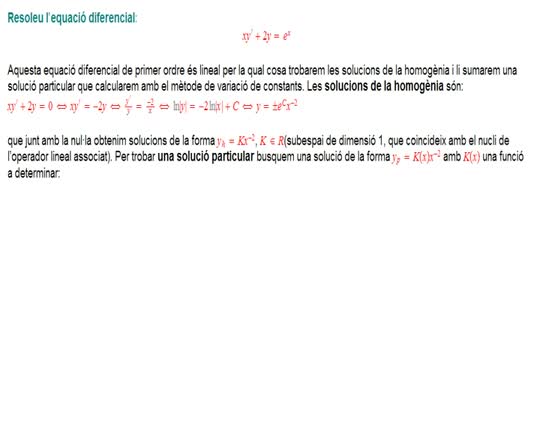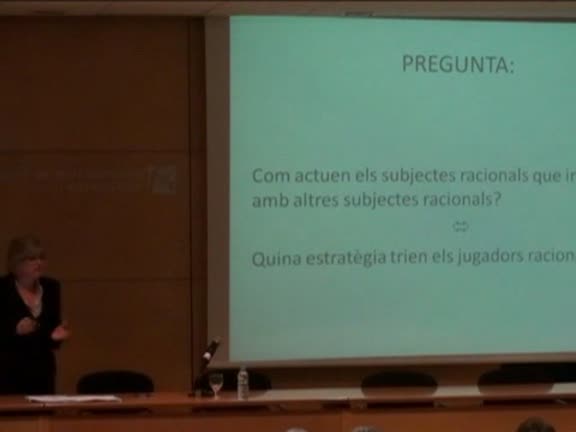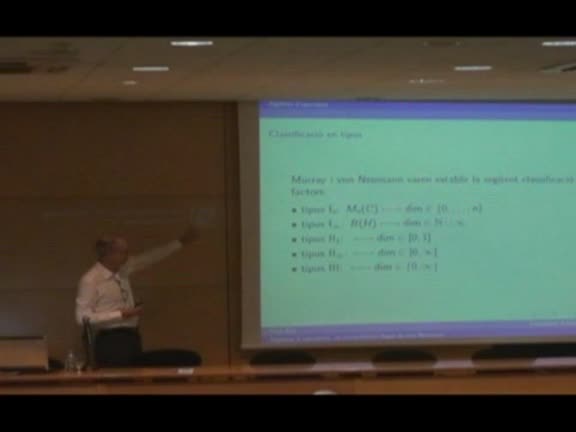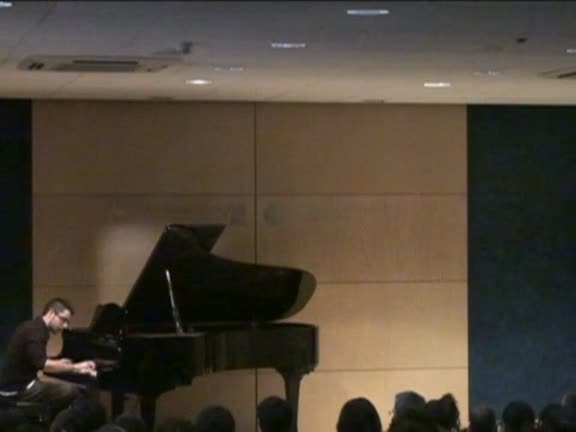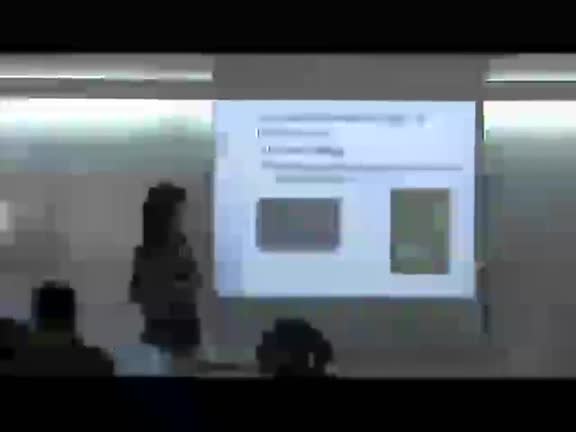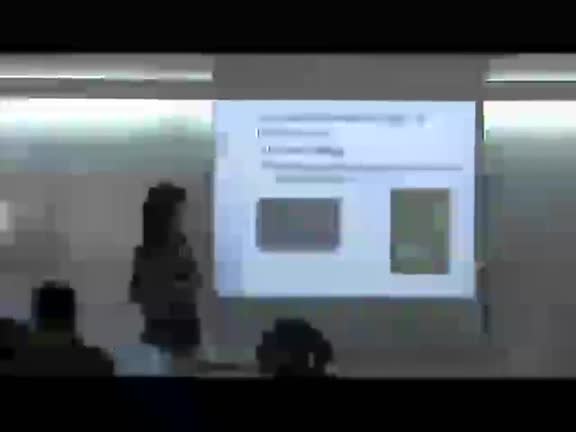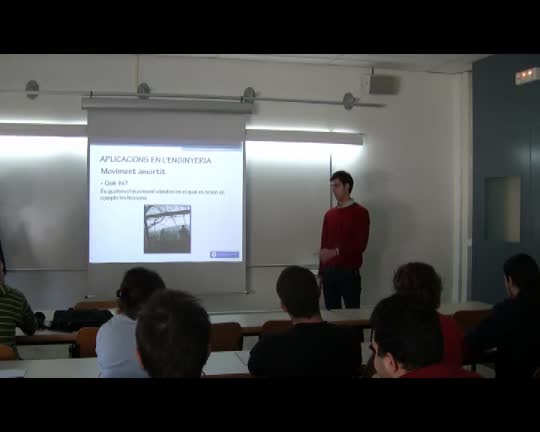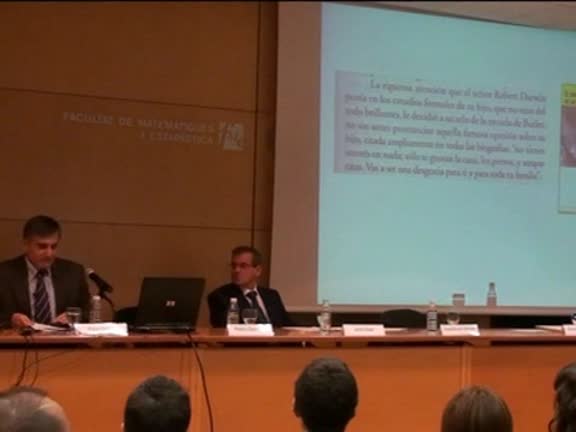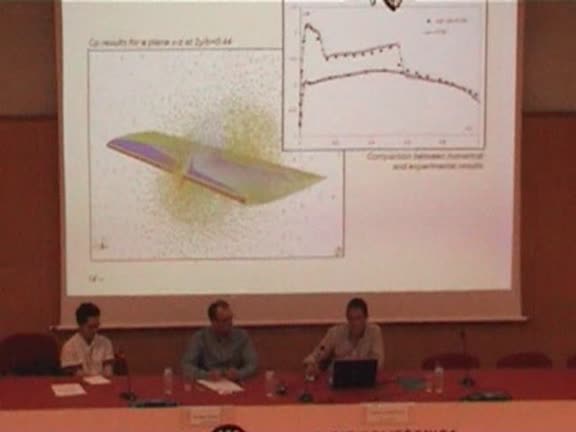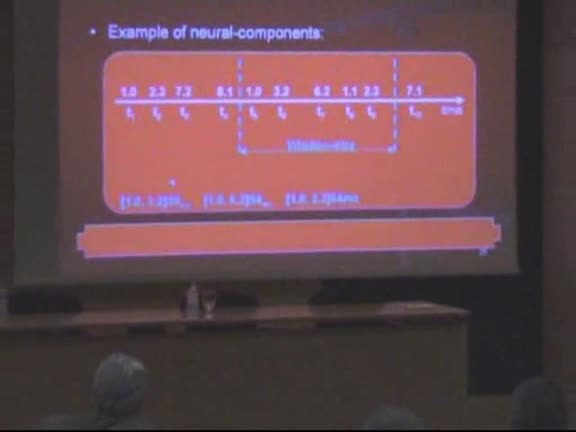Objectes multimèdia amb l’etiqueta: Matemàtiques i estadística
Resultats de la cerca
Exercici de resolució d’equació lineal de primer ordre a coeficients no constants i no homogènia
Accés obert
31 de març 2010
En aquest exercici es resol una equació lineal de primer ordre a coeficients no constants i no homogènia. La solució particular es calcula amb el mètode variació de constants
Von Neumann i la teoria de jocs. Jornada Von Neumann (Curs 2009-2010)
Accés obert
24 de febr. 2010
El gran matemàtic John von Neumann (1903-1957) tingué un paper primordial en la gènesi de la Teoria dels Jocs, la teoria matemàtica de les interaccions socials, avui una eina imprescindible de les ciències socials. Tot i que els pioners d'aquesta teoria -Borel, Zermelo, von Neumann
i altres- hi feren les seves aportacions inspirant-se en els jocs de taula com ara els escacs o el pòquer, de seguida deixaren clar el seu afany de construir una teoria matemàtica de totes les interaccions estratègiques que pogués convertir-se en una eina per dotar de rigor les ciències
socials. Aquest programa disciplinar assoleix la seva fi ta fundacional el 1944 quan von Neumann i l'economista Oskar Morgenstern publiquen Theory of Games and Economic Behavior. Aquest llibre, avui un clàssic, posava les bases d'una nova disciplina i fou el tret de sortida que esperonà el desenvolupament del la Teoria dels Jocs tal i com avui la coneixem. Amb la metxa ja encesa, l'impacte d'aquesta teoria en l'economia es féu esperar encara tota una generació i no fou fins a finals dels 1970 que la nova eina revolucionà la recerca econòmica. L'impacte d'aquesta teoria ha
estat contundent. Des de l'anàlisi de la competència entre empreses fins a les subhastes, la carrera armamentista, les lleis electorals, l'elecció dels candidats dels partits polítics, les campanyes de
vacunació o els contractes dels futbolistes, l'anàlisi científi ca de multitud de fenòmens del món real seria avui inconcebible sense la Teoria dels Jocs.
i altres- hi feren les seves aportacions inspirant-se en els jocs de taula com ara els escacs o el pòquer, de seguida deixaren clar el seu afany de construir una teoria matemàtica de totes les interaccions estratègiques que pogués convertir-se en una eina per dotar de rigor les ciències
socials. Aquest programa disciplinar assoleix la seva fi ta fundacional el 1944 quan von Neumann i l'economista Oskar Morgenstern publiquen Theory of Games and Economic Behavior. Aquest llibre, avui un clàssic, posava les bases d'una nova disciplina i fou el tret de sortida que esperonà el desenvolupament del la Teoria dels Jocs tal i com avui la coneixem. Amb la metxa ja encesa, l'impacte d'aquesta teoria en l'economia es féu esperar encara tota una generació i no fou fins a finals dels 1970 que la nova eina revolucionà la recerca econòmica. L'impacte d'aquesta teoria ha
estat contundent. Des de l'anàlisi de la competència entre empreses fins a les subhastes, la carrera armamentista, les lleis electorals, l'elecció dels candidats dels partits polítics, les campanyes de
vacunació o els contractes dels futbolistes, l'anàlisi científi ca de multitud de fenòmens del món real seria avui inconcebible sense la Teoria dels Jocs.
Àlgebres d'operadors: un extraordinari llegat de von Neumann. Jornada Von Neumann (Curs 2009-2010)
Accés obert
24 de febr. 2010
La teoria d'àlgebres d'operadors va ser desenvolupada per J. von Neumann en una sèrie d'articles al llarg de les dècades dels 30's i 40's del segle passat, alguns d'ells en col.laboració amb F.J. Murray. Les que avui en dia es coneixen com àlgebres de von Neumann són subàlgebres de l'àlgebra de tots els operadors lineals i continus sobre un espai de Hilbert complex, tancades
per l'operació de prendre l'adjunt i tancades en l'anomenada topologia forta dels operadors.
Els conceptes introduïts per von Neumann eren completament nous en la seva època, i encara avui en dia s'estan desenvolupant fèrtilment. En la meva xerrada, explicaré amb un cert detall aquests conceptes. A més donaré una visió general d'algunes de les parts de la matemàtica on el treball de von Neumann en àlgebres d'operadors ha tingut un impacte més significatiu, com per exemple la geometria no-commutativa d'Alain Connes i la teoria de nusos.
per l'operació de prendre l'adjunt i tancades en l'anomenada topologia forta dels operadors.
Els conceptes introduïts per von Neumann eren completament nous en la seva època, i encara avui en dia s'estan desenvolupant fèrtilment. En la meva xerrada, explicaré amb un cert detall aquests conceptes. A més donaré una visió general d'algunes de les parts de la matemàtica on el treball de von Neumann en àlgebres d'operadors ha tingut un impacte més significatiu, com per exemple la geometria no-commutativa d'Alain Connes i la teoria de nusos.
Aprendre a ensenyar matemàtiques : Els Poliedres
Accés obert
10 de des. 2009
Vídeo que serveix com a material docent del Màster Oficial - Formació de Professorat d'Educació Secundària Obligatòria i Batxillerat, Formació Professional i Ensenyament d'Idiomes (Especialitat de Matemàtiques)
Un grup d’estudiants que volen cursar disseny industrial presenten els poliedres i les seves propietats a partir de construccions fetes amb material manipulable, tot “tocant” els elements que els caracteritzen i les seves propietats.
Un grup d’estudiants que volen cursar disseny industrial presenten els poliedres i les seves propietats a partir de construccions fetes amb material manipulable, tot “tocant” els elements que els caracteritzen i les seves propietats.
Els Poliedres
Accés obert
10 de des. 2009
Presentació feta per alumnes de l'assignatura Fonaments Matemàtics dins la sessió "Una aproximació a Bolonya" on es pretén mostrar la importància de les matemàtiques en la nostra vida quotidiana.
Aprendre a ensenyar matemàtiques : El Número "e" en l'enginyeria i la vida quotidiana
Accés obert
16 de nov. 2009
Vídeo que serveix com a material docent del Màster Oficial - Formació de Professorat d'Educació Secundària Obligatòria i Batxillerat, Formació Professional i Ensenyament d'Idiomes (Especialitat de Matemàtiques)
Es presenta un exemple d’aprenentatge cooperatiu on uns estudiants d’enginyeria industrial exposen un treball en PBL. En aquest cas es treballa el número “e” i les seves aplicacions a l’enginyeria, mostrant la seva presència contextualitzada en la professió.
i llur relació amb la realitat.
Es presenta un exemple d’aprenentatge cooperatiu on uns estudiants d’enginyeria industrial exposen un treball en PBL. En aquest cas es treballa el número “e” i les seves aplicacions a l’enginyeria, mostrant la seva presència contextualitzada en la professió.
i llur relació amb la realitat.
El número "e" en l'enginyeria i la vida quotidiana
Accés obert
16 de nov. 2009
Presentació feta per alumnes de l'assignatura Fonaments Matemàtics dins la sessió "Una aproximació a Bolonya" on es pretén mostrar la importància de les matemàtiques en la nostra vida quotidiana.
Lliurament de diplomes de: Diplomatura en Estadística, Llicenciatura en Ciències i Tècniques estadístiques i Màster d'estadística i investigació operativa. Curs Von Neumann (2009-2010)
Accés obert
6 de nov. 2009
Acte de Lliurament de diplomes de: Diplomatura en Estadística, Llicenciatura en Ciències i Tècniques estadístiques i Màster d'estadística i investigació operativa
Lliurament de diplomes de: Llicenciatura en Matemàtiques, Màster de Matemàtica Aplicada i Màster d'Enginyeria Matemàtica. Curs Von Neumann (2009-2010)
Accés obert
23 d’oct. 2009
Acte de Lliurament de Diplomes de: Llicenciatura en Matemàtiques, Màster de Matemàtica Aplicada i Màster d'Enginyeria Matemàtica
Can Mathematics help to understand how does the brain work?. Curs Noether (2008-2009)
Accés obert
18 de set. 2009
How does the brain work is one of the most intriguing questions for the 21st century: what are the logical rules that the brain follows in motor and cognitive processes? Several projects are carried out in our lab (Neuromathlabin the Brain Centerin Bar-Illan University) trying to use mathematics to help understand the brain. We use a wide spectrum of methods from Differential Geometry, Topology, Statistics, Data Mining, Liner algebra, and more, and we collaborate with scientist from other disciplines like Neurophysiology, Neuro-surgery, Electrical Engineering, Psychology, and more. In the talk I'll mention 7 projects and will elaborate on 3 of them.


